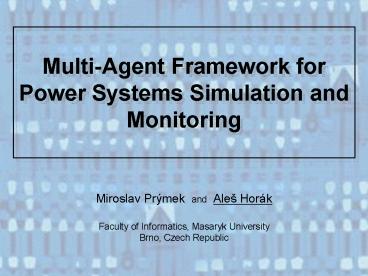Multi-Agent Framework for Power Systems Simulation and Monitoring - PowerPoint PPT Presentation
Title:
Multi-Agent Framework for Power Systems Simulation and Monitoring
Description:
A reduction of black-out risk in the Czech Republic is very topical as well. ... can use OOP models. IMPLEMENTATION - AGENTS. IMPLEMENTATION - AGENTS ... – PowerPoint PPT presentation
Number of Views:54
Avg rating:3.0/5.0
Title: Multi-Agent Framework for Power Systems Simulation and Monitoring
1
Multi-Agent Framework for Power Systems
Simulation and Monitoring
Miroslav Prýmek and Aleš Horák
Faculty of Informatics, Masaryk University Brno,
Czech Republic
2
Introduction the project
Academy of Sciences of Czech Republic, project
T100300414 Intelligent methods for increasing of
reliability of electrical networks The main
objective of the research project is an increase
in safety and reliability of operation of the
electric power system by developing new
intelligent methods. A reduction of black-out
risk in the Czech Republic is very topical as
well.
Participants Institute of
Informatics of AS CR, Faculty of Electrical
Engineering and Computer Science VSB TU Ostrava
and Faculty of Informatics MU Brno
3
Introduction the aim
- Reliability oriented maintenance
- possible replacement for the time oriented
maintenance - decreased expenses, increased effectivity and
flexibility of the maintenance - new methods for failure monitoring of power
network elements are necessary - simulation, prediction
- Simulation methods for reliability computation
- failure rate data acquisition
- development of adequate tools
- utilization of existing approaches (database of
failures) their extension with simulation
processes - Remote control elements
- tools for system integration (monitoring and
control)
4
ANALYSIS
- development of a communication framework based on
the multi-agent approach that allows - simulation of EPN processes
- on-line data acquisition
- interaction with monitoring and control systems
- prototype implementation (named Rice)
- Requirements
- decentralization
- platform independence
- performance scaling
- modularity and extensibility
- open standards
- security
- low-cost practical application
5
IMPLEMENTATION - AGENTS
- Multi-agent approach
- independent units with local interactions
- decisions based on their own knowledge about the
state of the world - querying and coordination of other agents
- Agents in the Rice system
- agent interface defined with message types
- similar to OOP principles can use OOP models
6
IMPLEMENTATION - AGENTS
7
IMPLEMENTATION - AGENTS
8
IMPLEMENTATION COMMUNICATION
- Agent communication
- 4-layers
- the network layer TCP/IP
- the agent level delivery layer CORBA
(independence on the network layer) - the message purpose layer KQML (virtual
knowledge base ontology) - the message subject itself
- This is not the only possibility, but it offers
the best flexibility
9
IMPLEMENTATION - EXAMPLE
Agent A transformation station transforming
very high voltage to high voltage Agent B
represents high voltage line Agent C represents a
distribution point
10
IMPLEMENTATION - EXAMPLE
11
IMPLEMENTATION - EXAMPLE
Agent B asks agent A for a notification for each
state change of A and each output voltage change
of A (subscribe sender B receiver
A timestamp 1113340454 reply-with
query_1 language KQML ontology
KQML_ontology content (ask
sender B receiver A reply-with
2 language Prolog ontology
Power_system content out_voltage(X),state(
Y) ) )
12
IMPLEMENTATION - EXAMPLE
Event - there is an outage on line B and the
current supply is cancelled, B sends to C a
message (tell sender B receiver C
timestamp 1113341454 in-reply-to
query_2 reply-with query_3 language
Prolog ontology Power_system content
out_voltage(0), state(fatal_failure) ) C can
react to this message in several ways - it can
set its output voltage to 0V too or it can switch
to another (backup) input line
13
VIEWER PROTOTYPE
14
CONCLUSIONS
- events can result in different actions (data
acquisition, simulation viewer, ...) - separate development of different parts of the
system is possible - enough flexibility to all possible development
plans - with new modules a complex system for
electrical power networks monitoring and control































